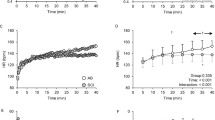Abstract
The objectives of this study were to examine the influence of the measurement protocol on the range and consistency of cervical motion (CM) in maximal vs. feigned limitation of CM, to explore some cognitive aspects of the feigning performance and to assess the effect of imagined pain vs. financial gain as a stimulus for the submaximal performance. The directions of flexion, extension, right and left rotation and right and left lateral flexion were measured in 26 normal subjects. Four protocols were compared: performance of CM with eyes open vs. eyes closed and testing at either a repetitive (within direction) or random (among directions) order. In each direction three measurements were recorded. Subjects were initially asked to move the head maximally, they were then presented with a vignette describing a fictitious accident involving the neck and were told to feign CM limitation in order to achieve unlawful compensation. In the third part, subjects were instructed to limit CM due to an imagined severe pain applying the repetitive order-eyes open paradigm only. Maximal CM paradigms were associated with significantly larger range (p=0.0000) and higher consistency (p=0.0000) compared the feigning paradigms. The eyes open-repetitive order protocol best separated between maximal and feigned performance. It was also indicated that the majority of subjects used the sensation of tension in the neck region as a cue for feigning while attempting to be as consistent as possible. Compared to feigning motivated by financial gain, limitation due to imagined pain resulted in significantly greater CM reductions and lesser consistency. The findings suggest that while feigning of motion impairment is probably based on somato-sensory input, the preferred CM testing protocol should consist of within direction repetitive movements with eyes open.

Similar content being viewed by others
References
Osterbauer P, Long K, Ribaudo T (1996) Three dimensional head kinematics and cervical range of motion in the diagnosis of patients with neck trauma. J Manipulative Physiol Ther 19:231–237
Dall’Alba PT, Sterling MM, Treleaven JM, Edwards SL, Jull GA (2001) Cervical range of motion discriminates between asymptomatic persons and those with whiplash. Spine 26:2090–2094
Kasch H, Bach FW, Jensen TS (2001) Handicap after acute whiplash injury. A one year prospective study of risk factors. Neurology 56:1637–1643
Kasch H, Stengaard-Pedersen K, Arendt-Nielsen L, Jensen TS (2001) Headache, neck pain and neck mobility after acute whiplash injury: a prospective study. Spine 26:1246–1251
Polatin PB, Mayer TG (1992) Quantification of function in low back pain. In: Turk DC, Melzack R (eds) Handbook of pain assessment. Guilford Press, New York, pp 32–48
Haines F (1999) Automobile insurance—trends in the neck soft-tissue injury claims. In: Proceedings of the First World Congress on Whiplash Associated Disorders, Vancouver, pp 90
Dvoŕak J, Antinnes JA, Panjabi M, Loustalot D, Benomo M (1992) Age and gender related normal motion of the cervical spine. Spine 17:S393–398
Dvir Z, Prushansky T (2000) Reproducibility and instrument validity of a new ultrasonography-based system for measuring cervical spine kinematics. Clin Biomech 15:648–654
Trott PH, Pearcy MJ, Ruston SA, Fulton I, Brien C (1996) Three dimensional analysis of active cervical motion: the effect of age and gender. Clin Biomech 11:201–206
Dvir Z, Werner V, Peretz C (2002) The effect of measurement order on cervical range of motion scores. Physiother Res Int 7:136–145
Dvir Z, Prushansky T, Peretz C (2001) Maximal vs. feigned active cervical motion in healthy subjects: the coefficient of variation as an indicator of sincerity of effort. Spine 26:1680–1688
Doege TC, Houston TP (1993) Guides to the evaluation of permanent impairment, 4th edn. American Medical Association, Chicago, pp 116–122
Dvir Z, Gal Eshel N, Pevzner Y (2004) The effect of simulated pain in cervical motion and its consistency in patients suffering from whiplash associated disorders. Clin J Pain (submitted)
Castro WH, Meyer SJ, Becke ME et al. (2001) No stress–no whiplash? Prevalence of whiplash symptoms following exposure to a placebo rear end collision. Int J Legal Med 114:316–322
Cassidy JD, Carroll L, Côte P, Lemstra M, Berglund A, Nygren A (2000) Effects of eliminating pain and suffering on the incidence and prognosis of whiplash claims. N Engl J Med 342:1179–1186
Author information
Authors and Affiliations
Corresponding author
Rights and permissions
About this article
Cite this article
Dvir, Z., Penso-Zabludowski, E. The effects of protocol and test situation on maximal vs. submaximal cervical motion: medicolegal implications. Int J Legal Med 117, 350–355 (2003). https://doi.org/10.1007/s00414-003-0402-7
Received:
Accepted:
Published:
Issue Date:
DOI: https://doi.org/10.1007/s00414-003-0402-7




